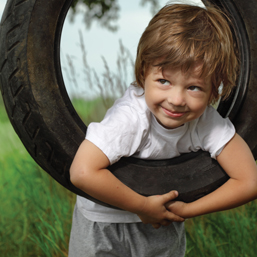
Wow,” the young boy says as he swings back and forth on the simple swing he made from rope and a piece of two-by-four. “I can’t believe I built this. This is the best idea that has ever come into my brain!”
“Yeah, it’s so cool!” says another boy, grinning from ear-to-ear. “I am so proud of myself for coming up with the idea for the steps and building them, so other little kids can use the swing, too!” Both boys are beaming with joy and pride. The teamwork, communication, problem-solving, and imagination that happened from this seemingly small activity is something that can never be replicated with traditional, static play materials - this is the magic of loose parts.
Loose parts are any materials that can be moved, carried, built and taken apart, lined up stacked together, and tinkered with. The theory of loose parts was created in 1972 by architect Simon Nicolson, who said, “In any environment, both the degree of inventiveness and creativity, and the possibility of discovery, are directly proportional to the number and kind of variables in it.” He believed that children are not born more or less creative. Instead, all children love to play, experiment, discover, invent, and have fun - they just need to be given the opportunity and the materials to do so.
One of the many beautiful benefits of loose parts play is its inclusivity. There is no prescription to play, no set outcomes or rules. It’s not a sport or game played to reach a set goal (get the ball into the net, tag friends, score more points than your opponents). Loose parts - such as tires, spools, rope, PVC pipe, and sticks - don’t have an inherent use; therefore, the play possibilities are limitless. A stick can become a wand, fishing rod, or sword. A bucket can become a helmet or drum. A spool can become the wheel of a car, table, or bird feeder. Pieces are snapped, glued, taped, bent, hidden, and tied to something else or used as decoration. The play is directed by the child based on their own needs, desires, and imagination, which empowers them to take charge of their own play environments. There is no gender, social, cognitive, physical ability, or age bias with loose parts. The materials are open-ended and encourage children to invent, construct, imagine, manipulate, and play in their own way.
While participating in unstructured loose parts play, particularly outdoors, children move more, sit less, and play longer. It increases their physical activity level, physical literacy, reduces stress, builds self-esteem, and engages all of their senses. They get the opportunity to engage with challenges and risky play, and learn how to recognize and overcome physical, social, and emotional risk. Children gain a sense of autonomy, responsibility, and confidence when they get to control the content and intent of their play.
When you give your children permission to play in a way that is meaningful to them, you allow them the opportunity to truly be themselves and express themselves in a way that feels safe. There is no right or wrong way to play with loose parts; children can create whole worlds without the fear of being judged. Loose parts play offers them the chance to be brave, vulnerable, and feel a sense of pride and confidence in their own abilities. Children are better able to focus, regulate emotions, and control their behaviors. They learn to problem-solve, take turns, negotiate, interact with their peers, and decide when to engage in group play or be alone to enjoy solitary play.
Some of my fondest memories from childhood are when I was outdoors with my peers, building and creating, without guidance from adults. We would spend hours building villages in the woods - adding to the villages each day, working as a team, deciding which materials would be sturdier to withstand the weather, and who was better skilled at which task. Our imaginations would turn scrounged-up material into furniture or decorations for our sanctuary away from the adult world.
When we were engaged in play, we were free! We were the kings and queens of our own world. The critical, healthy child development skills that were forged during loose parts play was an incredible bonus that should be shared with all children.
Sarah has a Bachelor of Physical Education from the University of Alberta and was the supervisor for The City of Calgary’s Mobile Adventure Playground. As the owner of Playful Adventures, she is passionate about bringing back unstructured, loose parts, outdoor play. Reach her at This email address is being protected from spambots. You need JavaScript enabled to view it..
Calgary’s Child Magazine © 2024 Calgary’s Child